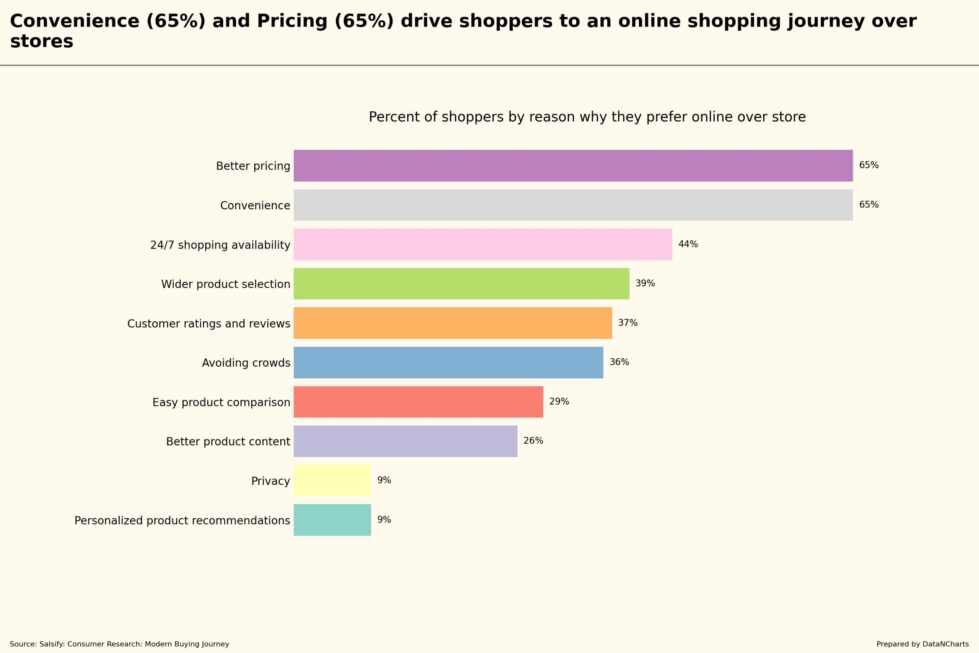Data Highlights
Nearly two-thirds (65%) shop online for convenience.
Nearly two-thirds (65%) shop online for better pricing.
Nearly half (44%) value 24/7 shopping availability.
About four in ten (39%) prefer the wider product selection online.
Over one-third (37%) rely on customer ratings and reviews.
More than one-third (36%) prefer avoiding crowds.
About three in ten (29%) prefer easy product comparisons online.
About one-quarter (26%) value better product content online.
A negligible share (9%) shop online for personalized product recommendations.
A negligible share (9%) prefer online shopping for privacy reasons.
Scope
Understanding why shoppers prefer online shopping clearly guides effective retail strategies. E-commerce continues growing, accelerated by convenience-driven consumer behavior and rising inflation pushing shoppers toward better pricing. This brief explores specific motivations driving consumers online. Readers gain clear, actionable consumer behavior insights to optimize digital consumer engagement and shopper marketing strategies.
Convenience and Pricing Drive Online Shopper Preferences (65%)
Convenience and better pricing drive nearly two-thirds (65%) of shoppers online. Consumers clearly value easy transactions, home delivery, and simple checkouts. Retail analytics confirm price-sensitive shoppers increasingly choose online channels. Brands offering frictionless shopping and clear pricing attract more online buyers.
Convenience leads directly into the next shopper priority.
Shoppers Expect 24/7 Online Availability (44%)
Nearly half (44%) of shoppers value online shopping’s 24-hour availability. Consumers demand flexibility in their shopper journey, expecting immediate access to products. Retailers providing always-on online stores attract these buyers consistently. Clearly meeting shopper expectations on availability significantly influences conversions.
Availability combines closely with variety as a key advantage.
Wider Product Selection Influences Decisions (39%)
About four in ten (39%) shoppers choose online shopping for greater product variety. Wider selection meets diverse consumer purchase patterns. Retailers offering extensive product ranges attract and retain shoppers effectively. Clearly highlighting product variety improves shopper satisfaction and increases repeat visits.
Variety alone does not complete consumer decisions without confidence-building content.
Customer Ratings and Avoiding Crowds Add Value (37%, 36%)
Over one-third (37%) of shoppers rely on ratings to guide their online choices. Ratings offer transparency, building consumer confidence. Similarly, more than one-third (36%) of shoppers prefer online to avoid crowded stores. Retailers clearly featuring trustworthy ratings and hassle-free shopping experiences directly influence shopper decisions.
Shoppers also prefer clear product comparisons online.
Easy Product Comparisons and Quality Content Matter (29%, 26%)
Nearly three in ten (29%) shoppers appreciate how easily they compare products online. Clear comparisons simplify the consumer decision-making process. About one-quarter (26%) value detailed product content online. Clearly organized product information increases buyer confidence and purchase likelihood.
Other factors impact fewer shoppers but remain noteworthy.
Minimal Influence from Personalization and Privacy (9%)
A negligible share (9%) prefers shopping online due to personalized recommendations or privacy reasons. Although important for select buyers, personalization and privacy offer limited overall impact. Retailers should prioritize more influential shopper needs first.
Insights and Opportunities
Clearly understanding why shoppers prefer online shopping helps retailers strategically optimize their digital channels and content.
- Firstly, brands must prioritize convenience and competitive pricing. By simplifying online checkout, reducing friction, and clearly displaying attractive prices, brands can expect increased conversions, lower cart abandonment, and higher customer satisfaction. Key performance indicators (KPIs) include conversion rates, average order values, and cart abandonment rates.
- Secondly, brands should clearly offer broad product selections and always-on availability. Ensuring products remain accessible, well-stocked, and consistently updated results in increased shopper loyalty, higher repeat purchase rates, and improved overall sales. Retailers can measure effectiveness through repeat purchase frequency, product-page engagement metrics, and total online revenue growth.
- Finally, brands must leverage ratings and detailed product content. Clearly presented, trustworthy reviews combined with helpful product descriptions boost shopper confidence, reduce uncertainty, and drive quicker purchase decisions. Retailers can expect improved consumer engagement, reduced returns, and higher shopper satisfaction. Measure success by monitoring product return rates, customer satisfaction ratings, and the rate of customer-generated reviews.
Retailers clearly optimizing these areas align closely with shopper expectations, improving shopper path to purchase outcomes and increasing customer loyalty.
